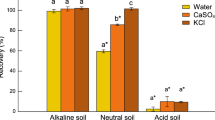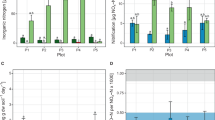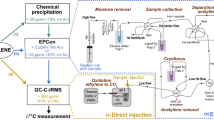Abstract
Nitrification is a key stage in the nitrogen cycle; it enables the transformation of nitrogen into an oxidized, inorganic state1,2. The availability of nitrates produced by this process often limits primary productivity and is an important determinant in plant community ecology and biodiversity3,4,5,6. Chemoautotrophic prokaryotes are recognized as the main facilitators of this process7, although heterotrophic nitrification by fungi may be significant under certain conditions8. However, there has been neither biochemical nor ecological evidence to support nitrification by photoautotrophic plants. Here we show how certain legumes that accumulate the toxin, 3-nitropropionic acid, generate oxidized inorganic nitrogen in their shoots, which is returned to the soil in their litter. In nitrogen-fixing populations this ‘new’ nitrate and nitrite can be derived from the assimilation of nitrogen gas. Normally, the transformation of elemental nitrogen from the atmosphere into a fixed oxidized form (as nitrate) is represented in the nitrogen cycle as a multiphasic process involving several different organisms. We show how this can occur in a single photoautotrophic organism, representing a previously undescribed feature of this biogeochemical cycle.
This is a preview of subscription content, access via your institution
Access options
Subscribe to this journal
Receive 51 print issues and online access
$199.00 per year
only $3.90 per issue
Buy this article
- Purchase on Springer Link
- Instant access to full article PDF
Prices may be subject to local taxes which are calculated during checkout

Similar content being viewed by others
References
Focht, D. D. & Verstraete, W. Biochemical ecology of nitrification and denitrification. Adv. Microb. Ecol. 1, 135–214 (1977)
Sprent, J. I. The Ecology of the Nitrogen Cycle (Cambridge Univ. Press, Cambridge, 1987)
Chapin, F. S. The mineral nutrition of wild plants. Annu. Rev. Ecol. Syst. 11, 233–260 (1980)
Berendse, F. Interspecific competition and niche differentiation between Plantago lanceolata and Anthoxanthum odoratum in a natural hayfield. J. Ecol. 78, 413–427 (1983)
Verhoeven, J. T. A., Koerselman, W. & Meuleman, A. F. M. Nitrogen or phosphorus-limited growth in herbaceous, wet vegetation: relations with atmospheric inputs and management regimes. Trends Ecol. Evol. 11, 494–497 (1996)
Wedin, D. A. & Tilman, D. Influence of nitrogen loading and species composition on carbon balance of grasslands. Science 274, 1720–1721 (1996)
Macdonald, R. M. in Nitrification (ed. Prosser, J. I.) 1–16 (IRL, Oxford, 1986)
Killham, K. in Nitrification (ed. Prosser, J. I.) 117–126 (IRL, Oxford, 1986)
Gustine, D. L. Aliphatic nitrocompounds in Crown Vetch: A review. Crop Sci. 19, 197–203 (1979)
Williams, M. C. & Barneby, R. C. The occurrence of nitro-toxins in North American Astragalus (Fabaceae). Brittonia 29, 310–326 (1977)
Williams, M. C. & Barneby, R. C. The occurrence of nitro-toxins in old world and South American Astragalus (Fabaceae). Brittonia 29, 327–331 (1977)
Williams, M. C. Nitrocompounds in Indigofera species. Agron. J. 73, 434–436 (1981)
Williams, M. C. Toxic nitro compounds in Lotus. Agron. J. 75, 520–522 (1983)
Salem, M. A., Williams, M., Wainwright, S. J. & Hipkin, C. R. Nitroaliphatic compounds in Hippocrepis comosa and other legumes in the European flora. Phytochemistry 40, 89–91 (1995)
Simpson, D. J., Wainwright, S. J. & Hipkin, C. R. Presence of 3-nitropropionic acid in widely distributed pasture legumes in Britain. Vet. Rec. 145, 169–171 (1999)
Alston, T. A., Porter, D. J. T. & Bright, H. J. Enzyme inhibition by nitro and nitroso compounds. Acc. Chem. Res. 16, 418–424 (1983)
Hipkin, C. R., Salem, M. A., Simpson, D. & Wainwright, S. J. 3-nitropropionic acid oxidase from horseshoe vetch (Hippocrepis comosa): a novel plant enzyme. Biochem. J. 340, 491–495 (1999)
Dijkstra, P. et al. Nitrogen stable isotope composition of leaves and roots of plants growing in a forest and a meadow. Isotopes Environ. Health Stud. 39, 29–39 (2003)
Baxter, R. L. et al. Fungal biosynthesis of 3-nitropropionic acid. J. Chem. Soc. Perkin Trans. 1, 2495–2501 (1992)
Rehder, H. & Schäfer, A. Nutrient turnover studies in alpine ecosystems. IV. Communities of the Central Alps and comparative survey. Oecologia 34, 309–327 (1978)
Pastor, J., Stillwell, M. A. & Tilman, D. Nitrogen mineralization and nitrification in four Minnesota old fields. Oecologia 71, 481–485 (1987)
Morecroft, M. D., Marrs, R. M. & Woodward, F. I. Altitudinal and seasonal trends in soil nitrogen mineralization rate in the Scottish Highlands. J. Ecol. 80, 49–56 (1992)
Shearer, G. & Kohl, D. H. N2-fixation in field settings: Estimations based on natural 15N abundance. Aust. J. Plant Physiol. 13, 699–756 (1986)
Arnon, D. I. & Hoagland, D. R. Crop production in artificial culture solutions and in soils, with special reference to factors influencing yield and absorption of inorganic nutrients. Soil Sci. 50, 463–483 (1940)
Matsumoto, H., Unrau, A. M., Hylin, J. W. & Temple, B. Spectrophotometric determination of 3-nitropropionic acid in biological extracts. Anal. Chem. 33, 1442–1444 (1961)
Everest, S. A., Hipkin, C. R. & Syrett, P. J. The effect of phosphate and flavin adenine dinucleotide on nitrate reductase activity of some unicellular marine algae. J. Exp. Mar. Biol. Ecol. 76, 263–275 (1984)
Parsons, T. R., Maita, Y. & Lalli, C. M. A Manual of Chemical and Biological Methods for Seawater Analysis (Pergamon, Oxford, 1984)
Acknowledgements
We thank R. Williams, D. Knight, R. Jones and K. Flynn for their assistance. M.A.S. thanks the Libyan government for financial support. The following botanic gardens supplied seed: Akureyri, Iceland; Bayreuth, Germany; Bern, Switzerland; Bonn, Germany; Bordeaux, France; Bratislava, Slovakia; Caen, France; Cambridge, UK; Dresden, Germany; Firenze, Italy; Halle, Germany; Hamburg, Germany; Innsbruck, Austria; Jenna, Germany; L'Aquila, Italy; Latte, Italy; Leicester, UK; Leipsig, Germany; Lisbon, Portugal; Oldenburg, Germany; Oxford, UK; Padova, Italy; Rouen, France; Sienna, Italy; Strasbourg, France; and Urbino, Italy.
Author information
Authors and Affiliations
Corresponding author
Ethics declarations
Competing interests
The authors declare that they have no competing financial interests.
Supplementary information
Supplementary Notes
Contains information about the production of 3-nitropropionic acid, nitrate and nitrite by axenic cultures of horseshoe vetch, including a photograph of a seedling growing in sterile culture. (DOC 38 kb)
Supplementary Table 1
The proportions of nitrate and nitrite in fresh leaves, senescing leaves and litter of 3NPA-containing species. (DOC 25 kb)
Supplementary Table 2
The amino acid contents of horseshoe vetch and white clover, in water culture and natural populations. (DOC 21 kb)
Rights and permissions
About this article
Cite this article
Hipkin, C., Simpson, D., Wainwright, S. et al. Nitrification by plants that also fix nitrogen. Nature 430, 98–101 (2004). https://doi.org/10.1038/nature02635
Received:
Accepted:
Issue Date:
DOI: https://doi.org/10.1038/nature02635
This article is cited by
-
Peculiarities of nitronate monooxygenases and perspectives for in vivo and in vitro applications
Applied Microbiology and Biotechnology (2021)
-
Nitrate-use traits of understory plants as potential regulators of vegetation distribution on a slope in a Japanese cedar plantation
Plant and Soil (2013)
-
Variations in nitrogen isotopic values among various particle-sized fractions in modern soil in northwestern China
Chinese Journal of Geochemistry (2011)
-
Nitrogen isotopic composition of plant-soil in the Loess Plateau and its responding to environmental change
Science Bulletin (2009)
Comments
By submitting a comment you agree to abide by our Terms and Community Guidelines. If you find something abusive or that does not comply with our terms or guidelines please flag it as inappropriate.



